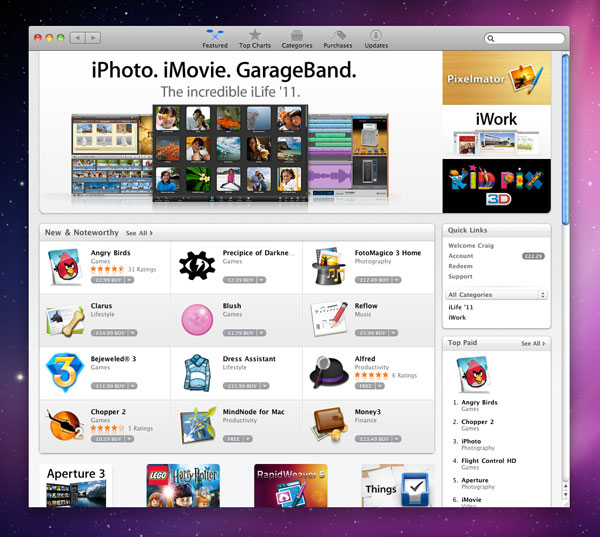So the Mac App Store just showed up as part of Mac OS X 10.6.6 (check Software Update if you don’t already have it installed). As expected, it pretty much confirms my thoughts that someone decided to shoot most of Apple’s designers some time around when brushed metal appeared, along with giving everyone at Cupertino a taste-ectomy. The app UI is just hideous, kicking conventions in the bollocks, laughing in the face of clarity, and mercilessly setting fire to UX and pushing it off a cliff.
Here’s what it looks like (with an front-page app slot shown at full size):


There are two major problems with the Mac App Store as it stands:
The toolbar. The Mac App Store lacks a standard toolbar for dragging the window about. Instead, it shoves the window controls, navigation and search field into a non-standard chunky toolbar. This is bad on several levels:
- There’s no standard ‘blank’ drag strip, enabling you to drag the window about. Instead, you must aim for and click specific blank areas between the various navigation items. This reduces usability and also obliterates accessibility for users who have less dexterity.
- The window controls are positioned in a different place to usual. This screws up muscle memory for Mac users used to ‘snapping’ to specific points to interact with controls. (Consistency is a cornerstone of good application design. It enables users to intuitively know how to interact with things. Apple is one of the worst offenders for breaching Mac OS X interface guidelines, despite chiding third-party developers for doing so).
- The window controls and primary back/forward navigation buttons are close together in terms of horizontal spacing, which may lead to accidental window zooming when attempting to navigate ‘back’. (Compare this to Safari, where the navigation controls are at the far left of the window.)
Still, Adobe might be happy, since Apple’s effectively validated the dire ‘Application Frame’ in the Creative Suite applications by doing the same thing itself (i.e. icons in the toolbar).
Clarity. I zoomed the Angry Birds box for a reason. Look at the price tag. It’s pretty indistinct and not easy to read. When slightly darker on a mouseover… well, it’s still pretty indistinct and not easy to read. Perhaps this is intentional, with Apple trying similar mind games to those used on restaurant menus. To me, it just looks like poor design. Someone liked the shade of grey and small text and went with it, rather than thinking if it offered enough contrast and clarity (a problem relatively common throughout the application). It reminds me of an era of web design, where designers became infatuated with small grey text on slightly darker grey backgrounds. And like many web pages of old, you of course cannot zoom the text in the Mac App Store.
I should point out that in terms of general use, the Mac App Store is fine. Applications download and install with a single click, and the process seems flawless. The clarity issue also improves somewhat on individual application pages (although the layout here is, to be kind, a total mess, like someone’s just slapped a wireframe together and a lazy boss has gone “yeah, whatever”). Furthermore, Apple’s also done some extremely aggressive pricing on its own products, which is great to see and should encourage more people to buy rather than copy software.
However, Apple used to stand for more than ‘good enough’ when it came to design in computing. While this is something that certainly still exists in Apple’s perfectionist approach to hardware design, something’s gone very wrong with its software interface design. Apple is fast becoming one of the worst developers in this area on its own platform.

